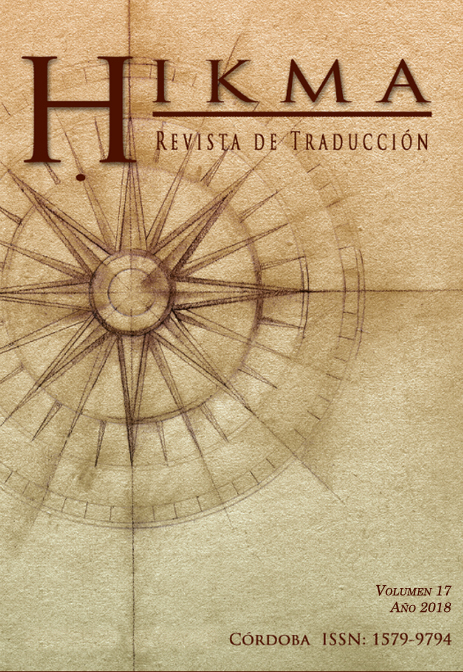Non-professional Subtitling in Italy: the Challenges of Translating Humour and Taboo Language
Main Article Content
Abstract
Fansubbing is one of the most common forms of non-professional audiovisual translation today, whose popularity is increasing thanks to digital technology advances. This happens especially in countries like Italy, where English is not the official language. The fansubbing phenomenon is at the same time a source of entertainment and knowledge, and it gives the possibility to fans to watch their favourite programme in their language. Despite being an illegal activity, the phenomenon has several benefits both for the programme itself and for the audience. Through the analysis of the amateur translation of the subtitles of an episode of Vicious, this paper will attempt to show the main translational differences between mainstream subtitling and fansubbing, focusing on the rendering of humour and taboo language.
Downloads
Article Details

This work is licensed under a Creative Commons Attribution-NonCommercial-ShareAlike 4.0 International License.
Authors who publish with this journal agree to the following terms:
1. Authors retain copyright and grant the journal right of first publication with the work simultaneously licensed under a Creative Commons Attribution License that allows others to share the work with an acknowledgement of the work's authorship and initial publication in this journal.
2. Authors are able to enter into separate, additional contractual arrangements for the non-exclusive distribution of the journal's published version of the work (e.g., post it to an institutional repository or publish it in a book), with an acknowledgement of its initial publication in this journal.
3. Authors are permitted and encouraged to post their work online (e.g., in institutional repositories or on their website) prior to and during the submission process, as it can lead to productive exchanges, as well as earlier and greater citation of published work (See The Effect of Open Access).
References
Bączkowska, Anna (2015). Quantitative study of non-professional subtitles and implications for corpus-based translator training. In: R. Antonini, C. Bucaria eds. 2015. Non-professional Interpreting and Translation in the Media. Frankfurt am Main: Peter Lang. Pp. 89-111.
Beseghi, Micol (2013). Having Fun in the classroom: Subtitling activities. Cercles 2013. 3(2), pp. 395-407.
Bold, Bianca (2011). The power of fan communities: an overview of fansubbing in Brazil. Tradução em Revista. 2, p.1-19. DOI: https://doi.org/10.17771/PUCRio.TradRev.18881
Bruti, Silvia, Zanotti, Serenella (2015). Non-professional subtitling in close-up: study of interjections and discourse markers. In: R. Antonini, C. Bucaria, eds. 2015. Non- professional Interpreting and Translation in the Media. Frankfurt am Main: Peter Lang GmbH. Pp. 231-256.
Bucaria, Chiara (2015). “I didn’t think it was appropriate”: Considerations on taboo humour in the subtitling classroom. In: R. Antonini, C. Bucaria, eds. 2015. Non-professional Interpreting and Translation in the Media. Frankfurt am Main: Peter Lang GmbH. Pp. 67-87.
Chiaro, Delia (2005). Foreword. Verbally Expressed Humor and translation: An overview of a neglected field. Humor. 18(2), pp. 135-145. DOI: https://doi.org/10.1515/humr.2005.18.2.135
Chiaro, Delia (2006). Verbally Expressed Humour on Screen: Reflections on Translation and Reception. The Journal of Specialized Translation. 6, pp. 198-208.
Díaz Cintas, Jorge (2013). Sobre comunicación audiovisual, Internet, ciberusuarios… y subtítulos. In: J.J. Martínez Serra, ed. Reflexiones sobre la traducción audiovisual: tres espectros, tres momentos. Valencia: Universidad de Valencia. Pp. 93-107.
Díaz Cintas, Jorge, Muñoz Sánchez, Pablo (2006). Fansubs: Audiovisual Translation In an Amateur Environment. The Journal of Specialized Translation . 6, pp. 37-52.
Gürkan, Aln (2013). The translation of swearwords in the fansubs and original subtitles. MSc dissertation. Imperial College London.
Ivarsson, Jan, Carroll, Mary (1998). Subtitling. Simrishamn: TransEdit HB.
Lakarnchua, Onuma (2015). Examining the potential of fansubbing as a language learning activity. Innovation in Language Learning and Teaching. 11(1), pp. 32-44. DOI: https://doi.org/10.1080/17501229.2015.1016030
Liu, Dayan (2014). On the Classification of Subtitling. Journal of Language Teaching and Research. 5(5) pp. 1103-1109. DOI: https://doi.org/10.4304/jltr.5.5.1103-1109
Massidda, Serenella (2015). Audiovisual Translation in the Digital Age: The Italian Fansubbing Phenomenon. Basingstoke: Palgrave Macmillan. DOI: https://doi.org/10.1057/9781137470379
Nornes, Abe Markus (1999). For an Abusive Subtitling. Film Quarterly. 52(3), pp. 17-34. DOI: https://doi.org/10.2307/1213822
O’Hagan, Minako (2008). Fan Translation Networks: an Accidental Translator Training Environment?. In: J. Kearns, ed. 2008. Translator and Interpreter Training: Issues, Methods and Debates. London: Continuum. Pp. 158-183.
O’Hagan, Minako (2012). From Fan Translation to Crowdsourcing: Consequences of Web 2.0 User Empowerment in Audiovisual Translation. In: A. Remael, P. Orero, M. Carroll, eds. 2012. Audiovisual Translation and Media Accessibility at the Crossroads. Amsterdam - New York: Rodopi. Pp. 25-41. DOI: https://doi.org/10.1163/9789401207812_004
Orrego-Carmona, David (2015). Internal structures and workflows in collaborative subtitling. In: R. Antonini, C. Bucaria, eds. 2015. Non-professional Interpreting and Translation in the Media. Frankfurt am Main: Peter Lang GmbH. Pp. 211-230.
Pedersen, Jan (2005). How is Culture Rendered in Subtitles?. MuTra 2005 – Challenges of Multidimensional Translation: Conference Proceedings. Pp. 1-18.
Pérez-González, Luis (2012). Amateur Subtitling and the pragmatics of spectatorial subjectivity. Language and Intercultural Communication. 12(4), pp. 335-352. DOI: https://doi.org/10.1080/14708477.2012.722100
Rembert-Lang, LaToya D. (2010). Reinforcing the Tower of Babel: The Impact of Copyright Law on Fansubbing. Intellectual Property Brief. 2(2), pp. 21-33.
Venuti, Lawrence (2002). Translating Humour. Performance Research. 7(2), pp. 6-16. DOI: https://doi.org/10.1080/13528165.2002.10871845
Wang, Dingkun (2014). Subtitling Humour in Transcultural Context. Chinese Semiotic Studies. 10(2), pp. 267-281. DOI: https://doi.org/10.1515/css-2014-0023
Wang, Fang (2014). Similarities and Differences between Fansub Translation and Traditional Paper-based Translation. Theory and Practice in Language Studies. 4(9), pp. 1904-1911. DOI: https://doi.org/10.4304/tpls.4.9.1904-1911

